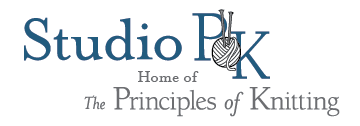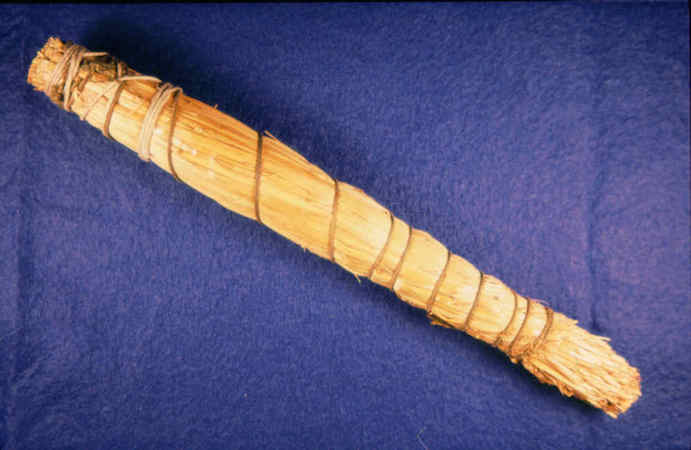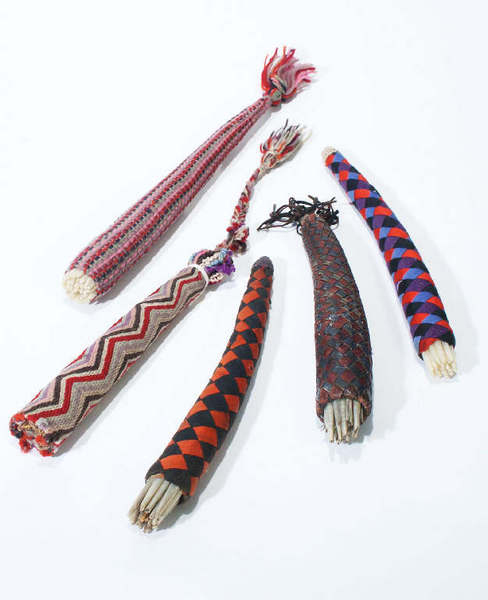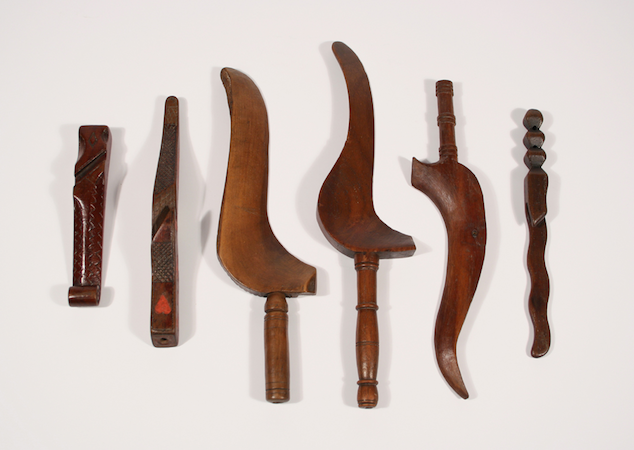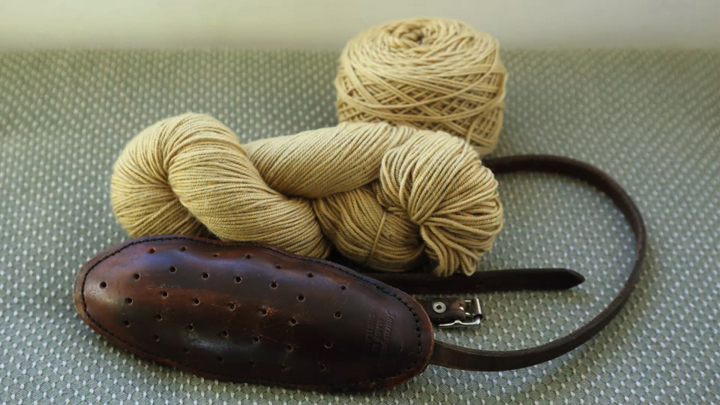History of Supported Needle Method
While doing research on knitting methods for the first edition of The Principles of Knitting, I learned that one of the oldest of them employed a device of some kind to support the right needle, freeing the hand to act as a shuttle and control tension.
There were tantalizing mentions of the method in various books, but little more; it seems to have been used by knitters for hundreds of years in Europe and Great Britain, but then was gradually abandoned after the knitting machine was introduced; with time the method was nearly forgotten. The only place where it is still part of a living knitting tradition is in Shetland, and it is still in use to some extent in northern England and Scotland.
Several kinds of devices were used, the simplest being a knitting “whisp” or “whisk” — no more than a small bundle of straw tied together and tucked into a waistband.
A more refined and decorative version was a bundle of goose quills, wrapped tightly with brightly colored yarn. One end of a double-point needle was inserted into the straw or the quills where it was held in position.
Another, more common device, was a knitting stick or sheath made of wood or metal. These were often beautifully carved or engraved, and can be seen in various museum collections. There is a hole bored in the center of the narrow end, into which a needle can be inserted.
The third type of device seems to be unique to Shetland and consists of a leather pad stuffed with horsehair and attached to a belt; the pad is worn at the right side of the waist or hip. There are holes punched in the surface of the pad, the end of a double-point needle is inserted into one of them, where it is held in a fixed position by the horsehair. In Shetland it is called a “makkin” or “makkin belt”, which translates as “knitting belt”. Knitters in Shetland wore their belts everywhere — walking to market with dried fish or walking home with a “kishie” full of peat, and when friends and family gathered around the fireplace, the belt would still be firmly in place because there was still knitting to be done.
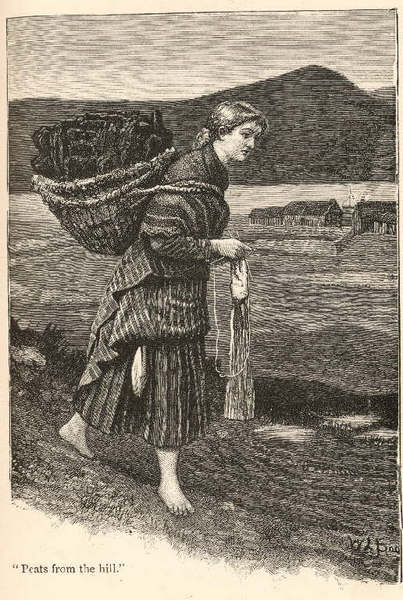
In Shetland, they knit while they walk as in this drawing of a girl carrying a kishie full of peat. “Shetland Knitter”, from “Britta, A Shetland Story”, George Temple. ©Shetland Museum, Lerwick, Shetland, #01434
In 1984, a few years after I began working on the book, my family and I traveled in Scotland and stopped for a few days in Edinburgh, where I hoped to learn more about the belt. I was directed to a small knitting store where it was thought someone would know about it, and found to my great delight that they were offering a class while I was there. I signed up immediately.
My mother had taught me how to knit with the Right Hand Method, tensioning the yarn with thumb and forefinger. At that time I still had very little facility with the Right Finger Method, which is used throughout Great Britain, and which is very similar to the method used with the belt.
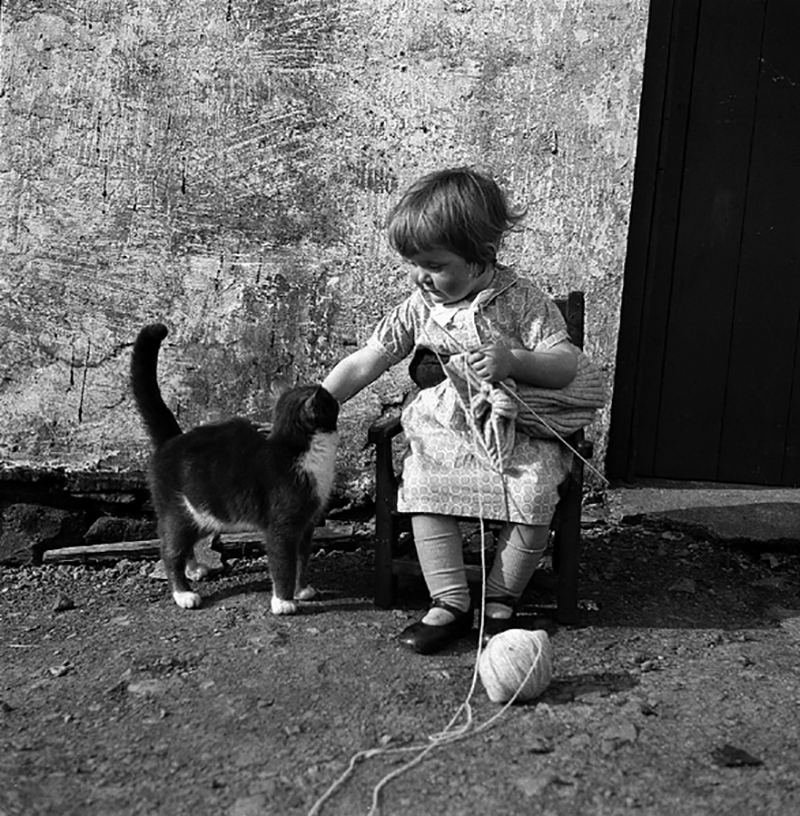
In Shetland they start knitting early; Little Chrissie Cheyne is wearing a knitting belt. “Girl with Cat”, J. Peterson, 1939-46, ©Shetland Museum, Lerwick, Shetland, #P03602
It is more challenging to learn a new way to knit as an adult, and to say I was all thumbs in this class would be an understatement. I made no progress at all in terms of facility, but was definitely impressed with the techique. I bought a belt and some needles, took them home with me, and practiced until it became second nature.
In order to write the chapter on knitting methods for my book, I learned every one of them. What I discovered in doing so was that they all have pros and cons — each is good at some things, and not quite as good at others. They are explained and compared in the book, but other than recommending one method to beginners because it is so easy to learn, there was no reason to favor one over another. And in any case, I strongly recommend that every knitter know how to do at least two methods, preferably three; this makes it possible to switch to the one that is most suitable for a particular project.
Privately, however, the belt had become my personal favorite. While I still use several other methods for special purposes, knitting with a belt has been my preferred method for the past 30 years. It is the one I used to knit all the swatches while doing research for both editions of the book (I wore my belt from Edinburgh every day, just like they do in Shetland). The reason it became my favorite was because I thought it had the fewest limitations and the most advantages of any of the methods, not least because it allowed me to knit for long hours without fatigue or strain.
I always thought it was unfortunate the method was not more widely known and used. After the second edition of The Principles of Knitting was published in 2012, I decided to see if there was something I could do to reintroduce this remarkable method to the larger knitting community. Unfortunately, the belts have not always been readily available (see below for a source in Shetland). Furthermore, the technique requires the use of double point needles, and while short ones work very well for small items like socks, the longer ones needed for garments have been difficult to find.
However, there are things about the traditional belt that I always felt were not ideal. It is no more than two pieces of leather stitched together and stuffed with horsehair. As a result it bulges out on both sides, and due to the rounded bottom, it tends to move while in use so I often had to stop and reposition it. Also, the buckle is small and sometimes comes undone. Basically, while a traditional belt has its charms, I thought it would be nice to give this venerable tool an aesthetic upgrade.
I decided to find a way to have belts made with a new design, but met with no success. Then I asked my multi-talented son Jesse if he wanted to give it a try. He’d never worked with leather before, but brushed that off and said he was interested. We embarked on a period of prototyping (that went on far longer than either of us anticipated), as we worked out the subtleties and refinements of our new version of this superb tool, but we are proud of the result.
The bottom of our new, patented belt is permanently stiffened and curved to fit the body comfortably so it stays in position. If you have used a traditional knitting belt before, you will immediately notice the difference once you put it on. We make it in eight beautiful colors of premium leather. The belts are sized and the PoK logo buckle is easy to manage and doesn’t come undone unless you want it to.
I would like to see more knitters become familiar with this wonderful technique, and encourage you to give it a try. Knitters who work with a belt for the first time quickly notice that it allows them to sit in a comfortable position, and the minimal movements required reduce stress and fatigue. Also, as you become familiar with working this way, you will find that your knitting tension is more consistent and the fabrics you make will be exceptionally even and beautiful.
Notes:
1. While other devices were once used to support the right needle in the UK and elsewhere, the knitting belt is unique to Shetland, and many people prefer to have a traditional one. Here are some links to websites where you can order one:
Jamieson’s of Shetland
http://www.jamiesonsofshetland.co.uk/knitting-belt-1236-p.asp.
Journeyman Leather
www.journeyman-leather.co.uk/knittingbelt8.html
Shetland Heritage Shop
https://www.shetlandheritageshop.com/Knitting-Belt.html
Jamieson & Smith, Shetland Wool Brokers. Use search function at bottom of page.
www.shetlandwoolbrokers.co.uk/Yarns
2. Please note that the Studio PoK knitting belt is protected by patents that cover our particular design; these patents place no restrictions whatsoever on the sale or manufacture of the traditional Shetland knitting belt.
3. For other information about knitting belts and sticks, see:
Old and Interesting blog
http://www.oldandinteresting.com/knitting-sheaths.aspx
Also see the charming article by Kate Davies about a treasured knitting stick:
http://Katedaviesdesigns.com/tag/knitting-stick/
4. I am very interested in learning more about the history of these devices, in Europe. I know they were also used in the Netherlands, as well as in Denmark, France, Spain, and Greece,. I have no doubt they were used elsewhere in Europe, but information is difficult to come by, especially in English. If anyone has more information on this topic, please write me at info@principlesofknitting.com
5. You can use double point needles of any length in a belt, however, I believe Studio PoK is the only regular US source for the 12” (30cm) needles we recommend. We also carry Addi 16” (40cm) aluminum needles, as well; this length is preferred by Shetland knitters.
Steel double-point needles made in China are often available on EBay. They are normally 16” (40cm), and are sold in sets with a range of sizes, some of which are too large to use with a knitting belt; also note that steel needles are heavy.
